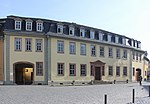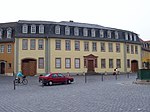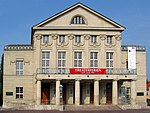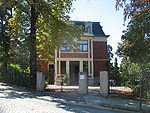Russian Orthodox Chapel, Weimar
1860 establishments in GermanyChurch buildings with domesChurches completed in 1860Churches in WeimarEastern Orthodox church buildings in Germany ... and 5 more
Europe Eastern Orthodox church stubsGerman building and structure stubsGerman church stubsGermany–Russia relationsRussian Orthodox chapels

The Russian Orthodox Chapel is a funerary chapel built in Weimar in 1860 for Grand Duchess Maria Pavlovna of Russia. It was constructed in the Historical Cemetery behind the Weimarer Fürstengruft, to which it is connected by an underground passage. Maria Pavlovna's coffin is located in the passage, with her husband Charles Frederick's coffin placed directly beside it. A spiral staircase leads to another underground connection to the Fürstengruft, though this is now closed by a metal plate.
Excerpt from the Wikipedia article Russian Orthodox Chapel, Weimar (License: CC BY-SA 3.0, Authors, Images).Russian Orthodox Chapel, Weimar
Windmühlenstraße,
Geographical coordinates (GPS) Address Nearby Places Show on map
Geographical coordinates (GPS)
| Latitude | Longitude |
|---|---|
| N 50.9725 ° | E 11.325555555556 ° |
Address
Hauptfriedhof
Windmühlenstraße
99425 , Westvorstadt
Thuringia, Germany
Open on Google Maps











